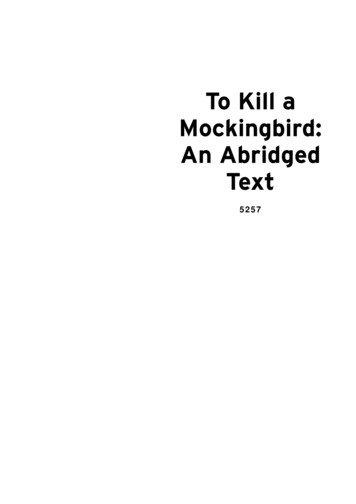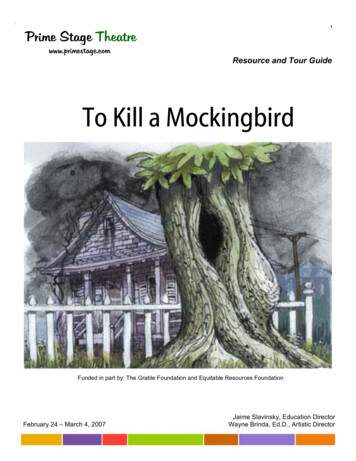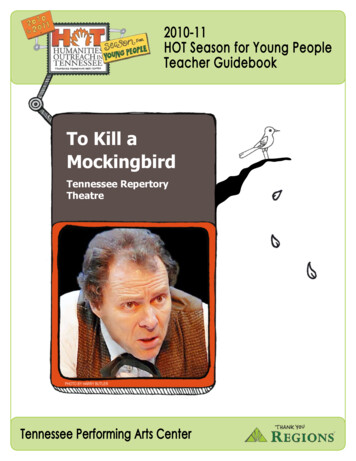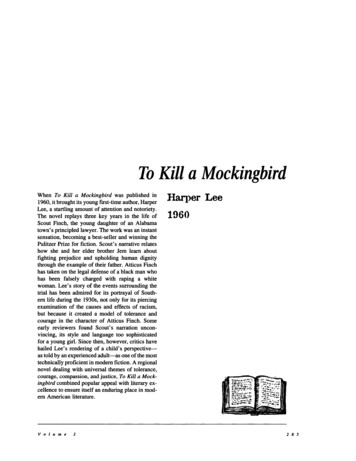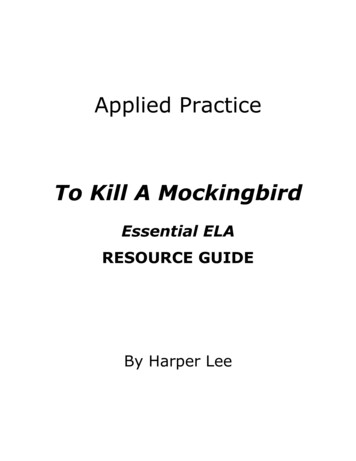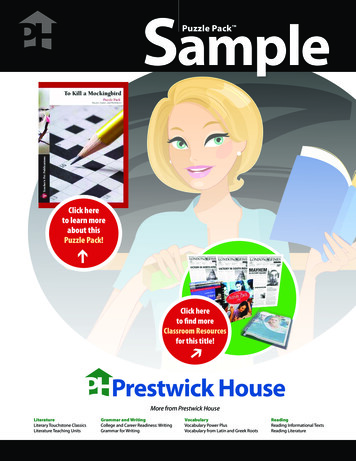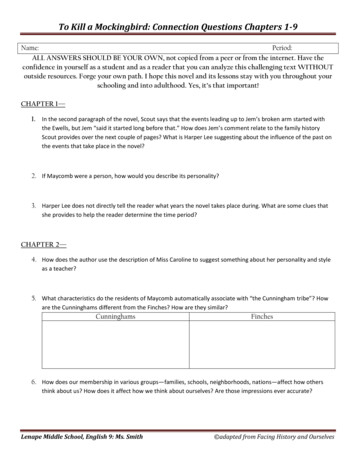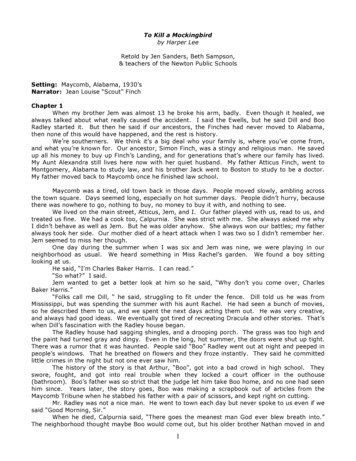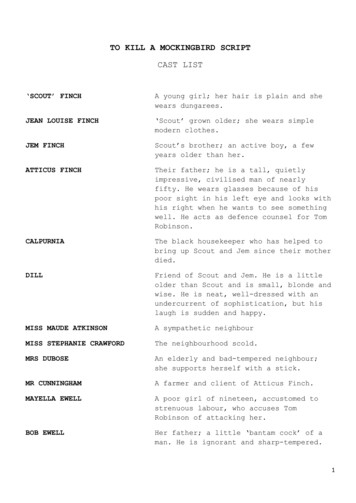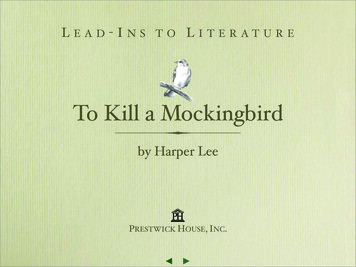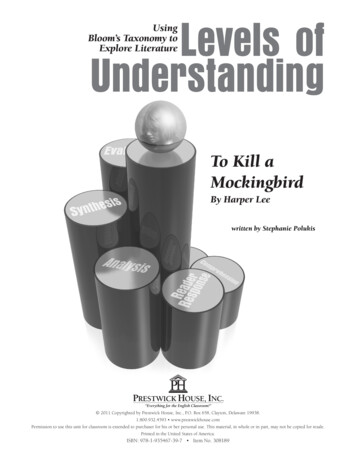
Transcription
Levels ofUnderstandingLevels of Understanding: To Kill a Mockingbird IntroductionUsingBloom’s Taxonomy toExplore LiteratureTo Kill aMockingbirdBy Harper Leewritten by Stephanie Polukis 2011 Copyrighted by Prestwick House, Inc., P.O. Box 658, Clayton, Delaware 19938.1.800.932.4593 www.prestwickhouse.comPermission to use this unit for classroom is extended to purchaser for his or her personal use. This material, in whole or in part, may not be copied for resale.Printed in the United States of America.ISBN: 978-1-935467-39-7 Item No. 308189
Levels of Understanding: To Kill a Mockingbird IntroductionIntroduction to Levels of UnderstandingFor many students,studying literature is like being lost in an alien universe, filled with hiddensymbols, structures, and meanings that only a scholar can uncover. Without a teacher’s direction, students lack the skills and confidence to evaluate a work of literature on their own, andinstead, will frequently turn to resources such as the Internet for guidance. As a result, they assumeanother writer’s views instead of developing their own.Levels of Understanding breaks down complex questions students will encounter into smaller parts,showing the steps a critical reader should take in order to develop a sound evaluation of a text. Eachsection of the guide contains five types of questions representative of Bloom’s learning domains—starting with the most basic and foundational skill, knowledge and comprehension, andgradually building to the highest skill, evaluation. All the way, reluctant students areprovided with the scaffolding they need to advance from one level of understanding tothe next.The five types of questions, again, representative of Blooms domains, are as follows: C omprehension—will ask the most basic questions to ascertain the students’fundamental understanding of the text: plot facts, character identification, etc. R eader Response—will ask the students to “respond” to the text by relating it topersonal experience or by presenting an opinion on a character or event. A nalysis—will require students to study how various techniques and literary ortheatrical devices (diction, symbolism, imagery, metaphors, asides, soliloquiesetc.) function in the text. Analysis questions do not ask the student to merelyidentify or define a literary, theatrical, or rhetorical device. S ynthesis—will bridge the gap between the analysis and evaluation questions,requiring students to look at other scenes in the text and draw conclusionsabout themes, motifs, or a writer’s style. Often, a synthesis questionwill require the student to draw on prior knowledge—what has beenlearned in class or through research—and/or information from sourcesother than the literary title being studied in order to arrive at a satisfactory answer. E valuation—will ask the student to make a qualitative judgmenton the text and determine whether a particular aspect of it is effective or ineffective.Other books may list Bloom’s taxonomy, define the terms, and offer a generalexample or two. Levels of Understanding, however, provides the teacher with thetitle-specific questions to allow you to effectively bring Bloom into your classroom.In addition, unlike other available products that claim to address Bloom’s “higher order thinkingskills,” Levels of Understanding does not teach students how to answer questions about a particulartext, but instead, helps them develop skills to evaluate literature critically and without guidance.These are skills that will not only help students prepare for standardized tests like the AdvancedPlacement Language and Literature exams, the SATs, and the ACTs, but will also give students theself-assurance to develop and articulate a personal view—a skill that will be highly advantageous tothem in college.This product, however, is not geared toward upper-level students only, but is a versatile guide thatcan be used for students of all ability levels—remedial through honors. The teacher may customizethe product to fit the class’s objectives and goals, determining which questions the students will answer. Additionally, the guide is entirely reproducible, and each major division begins on a new page,so you may use Levels of Understanding for the whole work of literature or only a specific section. Levels of Understanding: To Kill a Mockingbird Copyright 2011, Prestwick House, Inc.5
Levelsof Understanding:To KillMockingbird HowTo Use This UnitLevelsof Understanding:To aKilla Mockingbird IntroductionHow to Use this UnitELevels of Understanding: Using Bloom’s Taxonomy to Explore Literature unit is intended to be adeep and rich component of your literature program, whether your goal is to prepare your students for a large-scale assessment like the AP Literature exam or to challenge your students to readcarefully and to think deeply about what they have read.The questions in this guide are designed to be flexible and meet your needs. They can be used asach homework questions when students read the text independently. in-class reading check questions and “bell-ringer” journal entries. class discussion questions and prompts. focus questions for pre-writing and essay planning. review and study questions for assessment.While the Teacher’s Guide contains an answer key, you will find that the higher-order questions(especially synthesis and evaluation) have model answers that represent more than one possibleresponse. It would be inappropriate to penalize a student whose well-reasoned and supportableanswer did not match the “correct” answer in the guide.For this reason, we strongly recommend that you view the questions inthis guide as learning activities and not as assessment activities.Many of your students are likely to find the higher domains newand perhaps intimidating. Others might be alarmed at having tosupport their reader-response reactions and their evaluationswith an accurate comprehension of the text. The questionsin this guide should act as both scaffolding and safety net,guiding your students through a new reading and thinking process and allowing them to practice without fear of“failure.”The writing prompts, however, provide richassessment and evaluation opportunities. Everyprompt is designed to invite your students tooperate in one of the higher order domains, thusgiving students the opportunity to demonstratetheir ability, and giving you the opportunity toevaluate their progress.Whether you use Levels of Understanding: UsingBloom’s Taxonomy to Explore Literature as the core ofyour literature curriculum or as a supplement, theguide and writing prompts are designed to help yourstudents attain a deep understanding of the works theyread. Ideally, they will gain the type of understandingdemanded by Advanced Placement, International Baccalaureate, and most state standards, including the Common Core State Standards of the Council of Chief State SchoolOfficers and the National Governors Association. Levels of Understanding: To Kill a Mockingbird Copyright 2011, Prestwick House, Inc.7
Levels of Understanding: To Kill a Mockingbird IntroductionIntroduction to To Kill a MockingbirdNarrative Voice and StructureScout as a NarratorTo Kill a Mockingbird is told through a first-personnarrator, Jean Louise “Scout” Finch, who is also theprotagonist of the story. An adult version of Scout recountsevents that occurred in her hometown of Maycomb,Alabama while she was growing up. In the opening of thenovel, Scout says,When enough years had gone by to enable us to lookback on them, we sometimes discussed the events leadingto [Jem’s] accident. I maintain that the Ewells started itall, but Jem, who was four years my senior, said it startedlong before that. He said it began the summer Dill cameto us, when Dill first gave us the idea of making BooRadley come out.The plot begins the summer of Dill’s first visit, andalthough the narrator remains the adult Jean Louise, thenarrative perspective is that of Scout, a girl of seven. Thestory is filtered through a lens of childish innocence andmisunderstanding; however, some of Scout’s observationsseem too mature, indicating that either young Scout isextremely precocious or the adult narrator cannot completelyrefrain from intruding in the story of her young persona.There are several advantages and disadvantages withhaving a first person narrator.Advantages: First-person narration gives a personaltouch to the story. The narrator is intimately acquaintedwith the other characters and events, and the story ismeaningful to him or her; there is something about thestory that gives the narrator a need or desire to tell it.The voice of the first-person narrator—whether aparticipant in the events he or she narrates or merely awitness—allows readers to feel as if they are being givena glimpse of events as they are happening, as the narratorherself is experiencing or witnessing them. There is also,however, the added benefit that the first person narratorknows the outcome of the story before she begins tellingit. Thus, key events can be alluded to or gained insightscan be mentioned, enhancing the suspense and the reader’sdesire to continue with the story.The events in Jean Louise Finch’s story concern theyoung Scout, her father (Atticus), and her brother (Jem).Because Scout is the narrator, the reader can detect thestrong love she feels toward her family. Through Scout,the reader feels a strong connection to the characters andis able to empathize with them. Additionally, since thenarrator uses a Southern dialect and some juvenile slang,the language reinforces the ideas that this novel is set inAlabama and the narrator is a young girl.Disadvantages: The narrator is also a character in thestory and is affected by the actions and attitudes of theother characters. The nature of interactions between othercharacters and the narrator inevitably color how theseother characters are treated in the story. A third personnarrator may be able to tell a story objectively, withoutbias; a first person narrator cannot.Furthermore, an omniscient narrator is able to reporton the actions and thoughts of all characters; there isan element of transparency in the narration and less ofa chance of misunderstanding on the part of the reader.A first-person narrator, however, tells her story with herunique perspective and personal biases. Additionally, sincethe narrator knows only what she has witnessed, there is achance that the narrator can be deceived. Since stories toldthrough the first person point of view are subjective, theyare also unreliable.The text indicates that Scout is very close to her fatherand brother; hence, she probably portrays them in apositive way, overlooking some of their shortcomings. TheEwells, on the other hand, who oppose her father’s defenseof Tom Robinson, are portrayed negatively. It is likelythat Scout overlooks some of their redeeming qualitiesbecause of her personal resentment toward them. Fromthe standpoint of writing technique, Scout also wants toestablish them as antagonists. Moreover, Scout is youngwhen the Robinson case takes place, and it is not likelythat she understands everything that is happening. Eventhough the story is understood and reinterpreted throughan adult Scout, the adult’s intrusion in the child’s storyis minimal. As the adult narrator is relating events thathappened decades earlier when she was a young child, it isalso possible that the events did not happen exactly as sheunderstood them then and remembers them now.The BildungsromanA bildungsroman, a type of coming-of-age story, centers onthe protagonist’s undergoing a psychological, intellectual,social, or emotional change as the result of events in thestory. The protagonist is forced to leave home and go offon a journey to try to find his or her true self. Additionally,there is usually a conflict between the main character andsociety; he or she does not agree with the existing socialconventions and/or is reluctant to take his or her place insociety. Each trial the character faces gradually contributesto his or her self-actualization, and he or she returnshome changed. The character sees the error of his or herprevious way of thinking and willingly takes society’sLevels of Understanding: To Kill a Mockingbird Copyright 2011, Prestwick House, Inc.9
Teacher’s GuideLevels of Understanding: To Kill a MockingbirdWriting PromptsLevels of Understanding:Using Bloom’s Taxonomy of Learning Domainsto explore Harper Lee’s To Kill a MockingbirdWriting PromptsSection One: Analysis, Synthesis:At the beginning of the novel, Scout remarks, “the eventsleading to [Jem’s] accident” did not begin with Dill’s arrivalin Maycomb, but with Andrew Jackson’s “run[ning] theCreeks up the creek,” allowing for the development of theSouth. Scout suggests that the underlying problem thatdrives the events of this story is not personal, but cultural.Identify the central conflict of To Kill a Mockingbird,and explain how the problem is deeply embedded in theculture of the novel.Section Two: Analysis, Synthesis, Evaluation:Many people who evaluate literature using the Marxisttheory believe that all forms of oppression are derivedfrom a greater, underlying One: that One between thebourgeoisie’s oppression of the proletariat. In addition tothe apparent racism, anti-feminist views are evident inthe community. In a well-organized and -supported essay,support or refute the Marxist argument.Section Three: Analysis, Evaluation:In a well-organized essay, explain how the episode inChapter 12, in which Scout and Jem’s visit to the FirstPurchase Church develops and/or complicates the motifof racism in the novel. Focus on not only Scout and Jem’sevaluation of the church, but the church’s background,material possessions, parishioners, and sermon.Section Four: Analysis, Evaluation:Re-read the testimonies of the witnesses and Atticus’sclosing remarks in Chapters 17-20. Then, write athoughtful, well-supported essay in which you evaluateAtticus’s argument, analyzing the methods he uses topersuade the jurors, as well as any weaknesses in hisargument.Section Five: Analysis, Synthesis:To Kill a Mockingbird is a bildungsroman or a “coming ofage” story, in which the protagonists move from childhoodto adulthood, learning several important lessons andacquiring more mature viewpoints. Write a well-supportedessay in which you trace either Scout or Jem’s developmentthroughout the novel and explain how he or she hasevolved. Levels of Understanding: To Kill a Mockingbird Teacher’s Guide Copyright 2011, Prestwick House, Inc.39
Section OneLevels of Understanding: To Kill a MockingbirdStudent WorksheetsLevels of Understanding:Using Bloom’s Taxonomy of Learning Domainsto explore Harper Lee’sTo Kill a MockingbirdSection One: (Chapters 1 - 7)1. Identify the following characters. Who is he or she, and what is his or her relationship to other characters?What is his or her role in the plot?2. Describe the town of Maycomb. What is the general pace of life in the town? What are the prevailing faith, politics, and social customs of the residents?3. What does Miss Caroline learn about several of her students on the first day of school?4. What does Atticus teach Scout about human nature toward the end of Chapter 3?5. What rumors about Boo Radley circulate among the residents of Maycomb/children?40Levels of Understanding: To Kill a Mockingbird Student Worksheets Copyright 2011, Prestwick House, Inc.
Section TwoLevels of Understanding: To Kill a MockingbirdStudent WorksheetsTo Kill a MockingbirdSection Two: (Chapters 8 - 11)1. What causes Atticus to wake Scout and Jem in the middle of the night? Why?2. How does Miss Maudie react to the fire in her home?3. Why is Scout being harassed by some people in the community? What does Atticus advise her to do?4. Who is Tom Robinson? What do we know about him?5. Why does Atticus ask Jem to read to Mrs. Dubose?1. Is Mrs. Dubose a sympathetic character? Why or why not?44Levels of Understanding: To Kill a Mockingbird Student Worksheets Copyright 2011, Prestwick House, Inc.
Section ThreeLevels of Understanding: To Kill a MockingbirdStudent WorksheetsTo Kill a MockingbirdSection Three: (Chapters 12 - 16)1. What does the reader learn about Calpurnia’s family and background in this section?2. Explain why Calpurnia speaks differently when she is around other black people.3. Why does Dill run away from home?4. Who is Mr. Dolphus Raymond? What is his background? What is the most likely reason that he is treated likean outcast in the community?5. Why does Scout’s conversation with Mr. Cunningham cause him to break up the mob?6. In the passage about Mr. Raymond’s children, what is revealed about Maycomb’s definition of “black?”48Levels of Understanding: To Kill a Mockingbird Student Worksheets Copyright 2011, Prestwick House, Inc.
Student WorksheetsLevels of Understanding: To Kill a MockingbirdSection FourTo Kill a MockingbirdSection Four: (Chapters 17 - 24)1. Paraphrase the testimonies of the three witnesses: Mr. Tate, Bob Ewell, and Mayella Ewell, and of the accused,Tom Robinson.2. Why does Mr. Dolphus Raymond pretend to be an alcoholic?3. What is the “time-honored code” of Maycomb society that Atticus says Mayella had broken?1. Do you agree or disagree with Atticus’s expressed sentiments about individuals and mobs: “A court is only as soundas its jury, and a jury is only as sound as the men who make it up,” and, “A mob’s always made up of people, no matterwhat . Every mob in every little Southern town is always made up of people you know”? Explain your answer.Levels of Understanding: To Kill a Mockingbird Student Worksheets Copyright 2011, Prestwick House, Inc.53
Student WorksheetsLevels of Understanding: To Kill a MockingbirdSection FiveTo Kill a MockingbirdSection Five: (Chapters 25 - 31)1. What kinds of issues are discussed at the missionary circle meetings? Who are the Mrunas and J. Grimes Everett?2. What happens to Tom Robinson following the trial?3. What draws Scout closer to Aunt Alexandra at the end of Chapter 24?4. Explain in detail what happens to Scout and Jem on the way home from the pageant.5. How does Scout respond to meeting Boo Radley for the first time?1. Are you surprised by the community’s response to Robinson’s conviction and death? Why or why not?Levels of Understanding: To Kill a Mockingbird Student Worksheets Copyright 2011, Prestwick House, Inc.57
To Kill a Mockingbird. To Kill a Mockingbird , Levels of Understanding: s-Levels of Understanding: .

